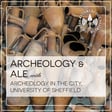
Is There a Doctor in the House - Arch and Ale 45
This month we have something different for our listeners
We invited a group of 6 Post-Graduate Researchers and Recently qualified Doctors to explain their research to the general public in no more than 10 minutes.
Our speakers and project titles were as follows:
Chris Dwan - Landscape Stability & the Formation of Social Memory in Prehistoric Britain.
Kate Faulkes - Tackling the Urban Godless Poor - How Successful were Sheffield’s Commissioner Churches 1826 - 1865.
Dr Nina Maaranen - Teeth are Awesome! An Archaeologist's Perspective.
Kelsey Madden - Digging for Italy - Vagnari Vicus and Faleril Novi.
Yvette Marks - A Re-assessment of Copper Smelting in the Late Neolithic and Early Bronze Age Agean.
Dr Sam Purchase - Point and Shoot: A Radiographic Analysis of Mastoiditis in Archaeological Populations from England’s North-East.
Archaeology & Ale is a monthly series of talks presented by Archaeology in the City, part of the University of Sheffield Archaeology Department’s outreach programme.
This talk took place on Monday 27th February 2023 at The Red Deer, Pitt Street, Sheffield
For more information about Archaeology in the City’s events and opportunities to get involved, please email archaeologyinthecity@sheffield.ac.uk or visit our website at archinthecity.wordpress.com. You can also find us on Twitter (@archinthecity), Instagram (@archaeointhecity), or Facebook (@archinthecity)
ArchPodNet
- APN Website: https://www.archpodnet.com
- APN on Facebook: https://www.facebook.com/archpodnet
- APN on Twitter: https://www.twitter.com/archpodnet
- APN on Instagram: https://www.instagram.com/archpodnet
- Tee Public Store
